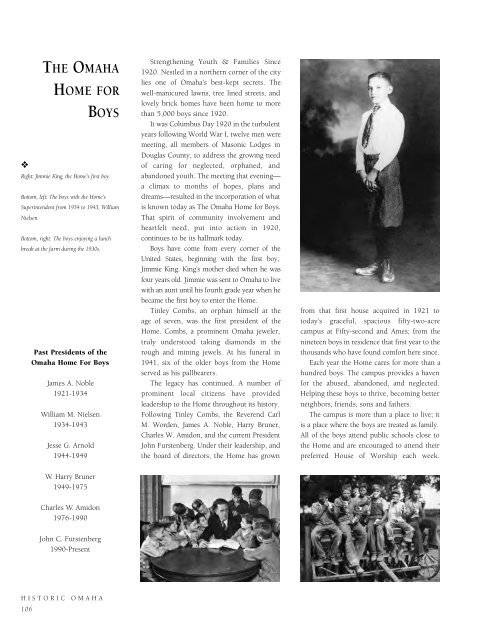Historic Omaha
An illustrated history of Omaha and the Douglas County area, paired with the histories of companies, families and organizations that make the region great.
An illustrated history of Omaha and the Douglas County area, paired with the histories of companies, families and organizations that make the region great.
Create successful ePaper yourself
Turn your PDF publications into a flip-book with our unique Google optimized e-Paper software.
❖<br />
THE OMAHA<br />
HOME FOR<br />
BOYS<br />
Right: Jimmie King, the Home’s first boy.<br />
Bottom, left: The boys with the Home’s<br />
Superintendent from 1934 to 1943, William<br />
Nielsen.<br />
Bottom, right: The boys enjoying a lunch<br />
break at the farm during the 1930s.<br />
Past Presidents of the<br />
<strong>Omaha</strong> Home For Boys<br />
James A. Noble<br />
1921-1934<br />
William M. Nielsen<br />
1934-1943<br />
Jesse G. Arnold<br />
1944-1949<br />
Strengthening Youth & Families Since<br />
1920. Nestled in a northern corner of the city<br />
lies one of <strong>Omaha</strong>’s best-kept secrets. The<br />
well-manicured lawns, tree lined streets, and<br />
lovely brick homes have been home to more<br />
than 5,000 boys since 1920.<br />
It was Columbus Day 1920 in the turbulent<br />
years following World War I, twelve men were<br />
meeting, all members of Masonic Lodges in<br />
Douglas County, to address the growing need<br />
of caring for neglected, orphaned, and<br />
abandoned youth. The meeting that evening—<br />
a climax to months of hopes, plans and<br />
dreams—resulted in the incorporation of what<br />
is known today as The <strong>Omaha</strong> Home for Boys.<br />
That spirit of community involvement and<br />
heartfelt need, put into action in 1920,<br />
continues to be its hallmark today.<br />
Boys have come from every corner of the<br />
United States, beginning with the first boy,<br />
Jimmie King. King’s mother died when he was<br />
four years old. Jimmie was sent to <strong>Omaha</strong> to live<br />
with an aunt until his fourth grade year when he<br />
became the first boy to enter the Home.<br />
Tinley Combs, an orphan himself at the<br />
age of seven, was the first president of the<br />
Home. Combs, a prominent <strong>Omaha</strong> jeweler,<br />
truly understood taking diamonds in the<br />
rough and mining jewels. At his funeral in<br />
1941, six of the older boys from the Home<br />
served as his pallbearers.<br />
The legacy has continued. A number of<br />
prominent local citizens have provided<br />
leadership to the Home throughout its history.<br />
Following Tinley Combs, the Reverend Carl<br />
M. Worden, James A. Noble, Harry Bruner,<br />
Charles W. Amidon, and the current President<br />
John Furstenberg. Under their leadership, and<br />
the board of directors, the Home has grown<br />
from that first house acquired in 1921 to<br />
today’s graceful, spacious fifty-two-acre<br />
campus at Fifty-second and Ames; from the<br />
nineteen boys in residence that first year to the<br />
thousands who have found comfort here since.<br />
Each year the Home cares for more than a<br />
hundred boys. The campus provides a haven<br />
for the abused, abandoned, and neglected.<br />
Helping these boys to thrive, becoming better<br />
neighbors, friends, sons and fathers.<br />
The campus is more than a place to live; it<br />
is a place where the boys are treated as family.<br />
All of the boys attend public schools close to<br />
the Home and are encouraged to attend their<br />
preferred House of Worship each week.<br />
W. Harry Bruner<br />
1949-1975<br />
Charles W. Amidon<br />
1976-1990<br />
John C. Furstenberg<br />
1990-Present<br />
HISTORIC OMAHA<br />
106
















